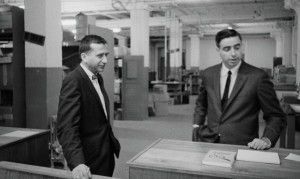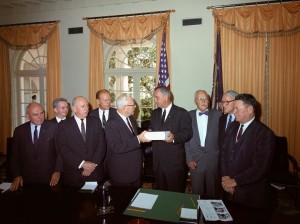FAQs
| FAQs
FREQUENTLY ASKED QUESTIONS ABOUT THE WARREN COMMISSION |
|
|---|---|
| What are the facts of the assassination of President Kennedy? John F. Kennedy, the 35th President of the United States, was fatally shot on November 22, 1963, at 12:30 pm Central Time, in Dealey Plaza, Dallas, Texas. At the time of the shots the president was riding in the presidential limo, accompanied by the First Lady, Jackie, Governor Connally of Texas, and Connally’s wife, Nellie. The president died soon after arriving at a hospital. Governor Connally was shot and wounded but survived. Lyndon Johnson was sworn in as the nation’s 36th President. Lee Harvey Oswald was apprehended within two hours of the assassination and taken into police custody. What was the Warren Commission? Although there was at the time no federal law making it a crime to kill the president, President Johnson directed the Federal Bureau of Investigation to take charge, conduct a full investigation of the facts, and report its findings to him. On November 24, Oswald was murdered by Jack Ruby in the basement of Dallas police headquarters as Oswald was being transferred to a more secure county jail. The assassination and Oswald’s murder two days later became the subject of worldwide speculation as to the persons or entities behind these events. The Dallas District Attorney was supervising an investigation of these developments, as was the State of Texas. In addition, Members of Congress in Washington were eager to conduct their own investigations of the assassination and the murder of Oswald. Faced with these several, potentially conflicting, investigations, President Johnson created a presidential commission of seven members, to be chaired by Chief Justice Earl Warren. The commission quickly became known as the Warren Commission. |
|
 Who was on it? Who was on it?The members of the Commission were:
The President’s executive order creating the commission directed it In order to “ascertain, evaluate, and report upon the facts relating to the assassination of the late President John F. Kennedy and the subsequent violent death of the man charged with the assassination.” Who was on the staff? The commission appointed J. Lee Rankin, a former solicitor general in the US Department of Justice during the Eisenhower Administration, to be its general counsel. The commission and Rankin selected fourteen lawyers as assistant counsels and another twelve persons (two historians, three IRS agents from government agencies, and seven lawyers) to assist the commission. With the exception of Howard Willens, who worked at the Justice Department headed by President Kennedy’s brother, Robert F. Kennedy, all of the lawyers working on the commission’s staff came from outside the government. What did it do? The Warren Commission conducted one of the most extensive murder investigations in history. The final publication included testimony from 552 witnesses and more than 3,100 exhibits. This information was compiled into a final, 888-page report. When did it file its report? The report was delivered to President Johnson on September 24, 1964, and made public three days later. |
|
 What were its principal conclusions? What were its principal conclusions?The Warren Commissions concluded that:
The Warren Commission report was published and released for sale to the public. Also released two months later were 26 volumes of supporting evidence, including witness transcripts and exhibits. Why have so many people disagreed with it? In the years since the assassination, many individuals have put forth countless different explanations of what happened in Dealey Plaza that day. These theories allege that a wide variety of entities – foreign nations, the Mafia, the Teamsters Union, US intelligence agencies, powerful individuals in the political sphere – may have formed a conspiracy which culminated in JFK’s murder. This phenomenon is not unique. In many cases, people search for dramatic explanations of dramatic events. The murder of a popular sitting President was a traumatic event for the United States and the world. JFK was seen as a great man, and it remains difficult for many people to accept that such a great man, the leader of our nation who was supposed to be protected better than anyone else, could have been murdered by a single, unbalanced individual. Additionally, the limited interrogation of Oswald and his subsequent murder have fed into the idea that Oswald was a part of a conspiracy, and Ruby was sent to silence him. Because the Commission’s main conclusion is negative – there was no conspiracy – it is impossible to logically prove, like any other negative proposition. While it remains logically possible that there was a conspiracy, no factual evidence to that effect was discovered during the ten-month commission investigation or has appeared in the nearly 50 years since the assassination. |

